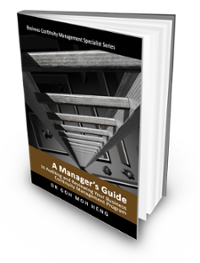Execute Corrective Actions
Corrective actions are taken to eliminate the cause of any non-conformity detected or other undesirable situations. This series of activities are to be undertaken:
- The Auditee responds to non-conformities using the corrective action report
- The Auditee is responsible for planning, implementing, and monitoring the corrective action plan
- Identification/agreement of non-conformity detected
- Use root cause analysis to review the issues
- Schedule for action to:
- Solve problem
- Implement solution
- Evaluate effectiveness
- Re-audit to verify
Corrective Action Procedures
These are the sample sequence of corrective action procedures:
- Monitor program and evaluate performance.
- Monitor and evaluate how actual incidents are handled.
- Monitor and evaluate program exercises and tests.
- Identify program performance deficiencies in planning, training, equipment and facility.
- Develop, define and clarify each problem statement for each deficiency.
- Assign task groups to develop corrective actions.
- Develop corrective actions to address deficiencies.
- Establish a development schedule for each action.
- Review evaluations of previous corrective actions.
- Identify possible solutions to each problem.
- Formulate options to address each problem.
- Recommend preferred corrective actions.
- Select a corrective action strategy.
- Prioritize the actions that should be taken.
- Develop and seek approval for the implementation schedule and resources for each corrective action.
- Provide resources and implement each approved corrective actions.
- Monitor the implementation of corrective actions.
- Test and evaluate corrective actions.
Focus of Re-Audit
This is the re-audit for verifying the previous non-conformity areas:
- Spot check related previous non-conformity areas
- Selected areas in greater depth
- Vary re-audit to meet the needs
- Target non-conformity
Audit Records
The content of a typical set of audit record should include the following:
- Reference and Date(s)
- Department/Operation/Activity
- Scope/Objective
- Auditor Name(s)
- Schedule and Check List
- Issued non-conformities
- Summary
- Wrap-up
- Auditor Notes
Resource
Goh, M. H. (2016). A Manager's Guide to Auditing and Reviewing Your Business Continuity Management Program. Business Continuity Management Series (2nd ed.). Singapore: GMH Pte Ltd.
Extracted from "Stage 4: Audit Follow-up"
Singapore  Government Funding for BCM-8530 Course
Government Funding for BCM-8530 Course
The next section applied to Singaporean and Singapore permanent residents. Click button "Government Funding Available" to find out more about the funding that is available from the Singapore government. This include the CITREP+, SkillsFuture Credit and UTAP.
Find out more about Blended Learning BCM-8530 [BL-A-5] & BCM-8030 [BL-A-3]
 |
 |
 |
 |
![TMM [BL-A-5]](https://no-cache.hubspot.com/cta/default/3893111/e7af9322-15cb-412d-91b6-59cd388ee6e9.png) |
![Register [BL-A-5]](https://no-cache.hubspot.com/cta/default/3893111/bb38417e-6241-4057-b90c-f319f31a494e.png) |
 |
Please feel free to send us a note if you have any of these questions to sales.ap@bcm-institute.org |  |





